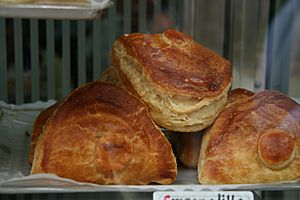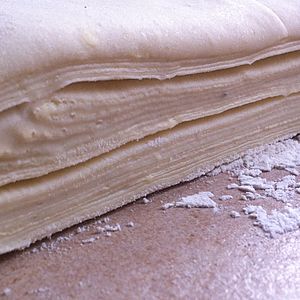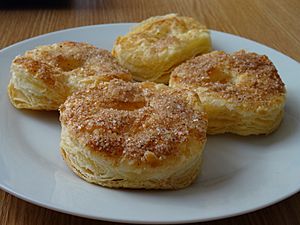Puff pastry facts for kids

A chicken pot pie made with puff pastry
|
|
| Alternative names | Water dough, détrempe, pâte feuilletée |
|---|---|
| Type | Pastry |
| Region or state | Spain |
| Main ingredients | Butter, flour, water |
Puff pastry, also known as pâte feuilletée, is a super light and flaky pastry. It's made from a special kind of dough that has many layers. These layers are created by folding butter or other solid fat into the dough over and over again.
When you bake puff pastry, the fat melts and creates gaps. Water in the dough turns into steam, which pushes these layers apart. This makes the pastry puff up and become wonderfully light and airy!
Contents
History of Puff Pastry
Puff pastry seems to be related to an older Greek pastry called phyllo. Both are used to make layered treats. Over time, thin sheets of dough brushed with olive oil likely turned into the layered dough we know today, with butter folded inside.
The modern puff pastry we enjoy probably started in Spain. This might have been influenced by Arab or Moorish cooking styles. The first known recipe for puff pastry using butter or lard appeared in a Spanish cookbook. This book was called Libro del arte de cozina (Book on the art of cooking). It was written by Domingo Hernández de Maceras and published in 1607. Maceras was a head cook at a college in the University of Salamanca. He already knew the difference between puff pastry that was filled and puff pastry tarts.
Another Spanish chef, Francisco Martínez Motiño, also shared many puff pastry recipes. He was the head chef for Philip II of Spain and published his book in 1611. In his book, puff pastry was used a lot, especially for savory meat pies. Some people even thought Martínez Montiño invented puff pastry!
By the early 1600s, puff pastry was clearly very popular in Spain. There's a story that the French painter and cook Claude Lorrain invented it. The story says he was making buttery bread for his sick father. But this story isn't true. The first French recipe for puff pastry was published in 1653, almost 50 years after the Spanish recipes.
How Puff Pastry is Made
Making puff pastry dough can take a lot of time and effort. It needs to be kept cool, around 16°C (60°F). This is important so the butter or fat doesn't melt and stays solid. The dough also needs to rest between each time it's folded and rolled out. This resting time allows the dough to relax and helps create all those amazing layers.
When you fold the dough, you create many layers. For example, if you fold the dough in three and repeat this four times, you end up with 81 layers! Some chefs aim for hundreds of layers for a very fine pastry.
You can buy puff pastry already made in grocery stores. Different kinds of fat are used, like butter, vegetable shortenings, lard, and margarine. Butter is often used because it gives the pastry a rich taste. Other fats might make the pastry rise even more, but they can sometimes leave a waxy feeling in your mouth.
Types and Differences
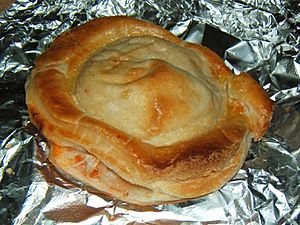
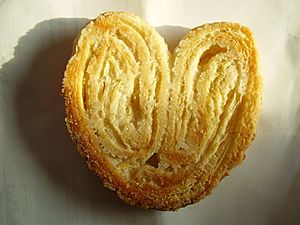
Because making traditional puff pastry takes so long, there are faster ways to make it. These are often called "blitz," "rough puff," or "flaky pastry." In these quicker recipes, the butter is mixed into the dough differently, making them a bit like a folded shortcrust pastry.
Sometimes, puff pastry dough is also made with baker's yeast. This creates pastries like croissants or Danish pastry. While they are flaky and layered, they are not always considered true puff pastries because of the yeast.
Puff pastry is different from phyllo pastry. Phyllo dough is made with flour, water, and fat, and it's stretched out very thin instead of being rolled. When you use phyllo, you brush a little oil or melted butter between each layer. Phyllo becomes crispy when baked, but it doesn't puff up as much as puff pastry. Puff pastry is also different from Austrian strudel dough, which is more like phyllo.
What Puff Pastry is Used For
- Beef Wellington
- Cheese straws
- Croline
- Croissants
- Galette des rois
- Jambons
- Miguelitos
- Mille-feuille
- Palmier
- Pastel de nata
- Pithivier
- Sausage rolls
- Steak and kidney pie and other types of pie
- Strudel
- Tarte conversation
- Tarte Tatin
- Torpedo dessert
- Turnovers
See also
 In Spanish: Hojaldre para niños
In Spanish: Hojaldre para niños


